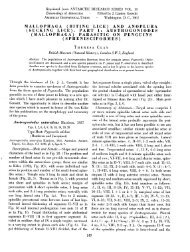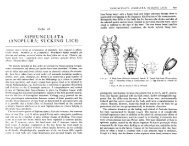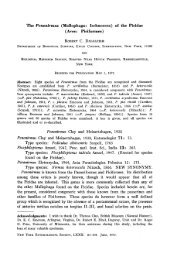Infestation of people with lice in Kathmandu and Pokhara, Nepal
Infestation of people with lice in Kathmandu and Pokhara, Nepal
Infestation of people with lice in Kathmandu and Pokhara, Nepal
Create successful ePaper yourself
Turn your PDF publications into a flip-book with our unique Google optimized e-Paper software.
Medical <strong>and</strong> Veter<strong>in</strong>ary Entomology (2004) 18,212–213<br />
SHORT COMMUNICATION<br />
<strong>Infestation</strong> <strong>of</strong> <strong>people</strong> <strong>with</strong> <strong>lice</strong> <strong>in</strong> <strong>Kathm<strong>and</strong>u</strong> <strong>and</strong><br />
<strong>Pokhara</strong>, <strong>Nepal</strong><br />
S. K. S. POUDEL * <strong>and</strong> S . C . B A R K E R y<br />
* Department <strong>of</strong> Science,Janapriya Multiple Campus,<strong>Pokhara</strong>,<strong>Nepal</strong> <strong>and</strong> y Department <strong>of</strong> Microbiology <strong>and</strong> Parasitology,<br />
<strong>and</strong> Institute <strong>of</strong> Molecular Biosciences,University <strong>of</strong> Queensl<strong>and</strong>,Australia<br />
Abstract. The prevalence <strong>of</strong> <strong>in</strong>festation <strong>with</strong> head <strong>lice</strong> <strong>and</strong> body <strong>lice</strong>, Pediculus spp.<br />
(Phthiraptera: Pediculidae) <strong>and</strong> pubic (crab) <strong>lice</strong> Pthirus pubis (L.) (Phthiraptera:<br />
Pthiridae),was recorded from 484 <strong>people</strong> <strong>in</strong> <strong>Nepal</strong>. The prevalence <strong>of</strong> head <strong>lice</strong><br />
varied from 16% <strong>in</strong> a sample <strong>of</strong> <strong>people</strong> aged 10–39 years <strong>of</strong> age,to 59% <strong>in</strong> street<br />
children. Simultaneous <strong>in</strong>festations <strong>with</strong> head <strong>and</strong> body <strong>lice</strong> (double <strong>in</strong>festations)<br />
varied from 18% <strong>in</strong> slum children to 59% <strong>in</strong> street children.<br />
Key words. Pediculus spp., Pthirus pubis,body <strong>lice</strong>,crab <strong>lice</strong>,head <strong>lice</strong>,Phthiraptera,<br />
prevalence,<strong>Nepal</strong>.<br />
The <strong>lice</strong> which <strong>in</strong>fest humans are considered by some<br />
authors to belong to three dist<strong>in</strong>ct species: Pediculus capitis<br />
DeGeer,body (clothes) <strong>lice</strong>,Pediculus humanus L. (Phthiraptera:<br />
Pediculidae) <strong>and</strong> pubic (crab) <strong>lice</strong> Pthirus pubis (L.)<br />
(Phthiraptera: Pthiridae) (e.g. Busv<strong>in</strong>e,1978). In contrast,<br />
other authors consider body <strong>and</strong> head <strong>lice</strong> to be conspecific:<br />
Pediculus humanus capitis De Geer <strong>and</strong> Pediculus h. humanus<br />
L. (Durden & Musser,1994).<br />
Body <strong>lice</strong> are known to transmit three pathogenic bacteria<br />
among humans: Bartonella qu<strong>in</strong>tona (trench fever),<br />
Borellia recurrentis (recurrent fever) <strong>and</strong> Rickettsia prowazekii<br />
(louse-borne typhus). It is widely held <strong>in</strong> the literature<br />
that head <strong>lice</strong> do not or cannot transmit pathogenic bacteria<br />
to <strong>people</strong>,but the evidence for this hypothesis is <strong>in</strong>conclusive<br />
(see Rob<strong>in</strong>son et al.,2003). Indeed,the only laboratory<br />
experiments to test the ability <strong>of</strong> head <strong>lice</strong> to transmit<br />
pathogenic bacteria <strong>in</strong>dicate that head <strong>lice</strong> may <strong>in</strong>deed be<br />
able to act as vectors <strong>of</strong> at least one bacterium, R. prowazekii<br />
(see Rob<strong>in</strong>son et al.,2003).<br />
The prevalence <strong>of</strong> <strong>lice</strong> on <strong>people</strong> <strong>in</strong> <strong>Nepal</strong> has not been<br />
<strong>in</strong>vestigated previously. In the present study,the prevalence<br />
<strong>of</strong> body <strong>lice</strong>,head <strong>lice</strong> <strong>and</strong> pubic <strong>lice</strong> was recorded from<br />
<strong>people</strong> <strong>in</strong> the two largest cities <strong>of</strong> <strong>Nepal</strong>,<strong>Kathm<strong>and</strong>u</strong> <strong>and</strong><br />
<strong>Pokhara</strong>. The prevalence <strong>of</strong> <strong>in</strong>festations <strong>with</strong> <strong>lice</strong> was determ<strong>in</strong>ed<br />
for samples <strong>of</strong> five groups <strong>of</strong> <strong>people</strong>: (i) orphanage<br />
children,aged 4–14 years,from Paropakar Orphanage,<br />
Correspondence: Shree Kanta Sharma Poudel,Janapriya Multiple<br />
Campus,<strong>Pokhara</strong>-8,Kaski,G<strong>and</strong>aki,<strong>Nepal</strong>. Tel.: þ977 61 31822;<br />
e-mail: shreekantas@hotmail.com<br />
<strong>Kathm<strong>and</strong>u</strong>; (ii) school children,aged 4–14 years,from<br />
Paropakar Adarsha High School,<strong>Kathm<strong>and</strong>u</strong>; (iii) street<br />
children,aged 4–14 years,from <strong>Pokhara</strong>; <strong>and</strong> (iv) slum<br />
children,aged 4–14 years,<strong>Pokhara</strong>. The street children<br />
slept together <strong>in</strong> rudimentary iron shelters at recycl<strong>in</strong>g<br />
yards,whereas the slum children lived <strong>with</strong> their families<br />
<strong>in</strong> slums. The f<strong>in</strong>al group (v) was composed <strong>of</strong> <strong>people</strong> from<br />
Wards 19 <strong>and</strong> 20 <strong>of</strong> <strong>Kathm<strong>and</strong>u</strong>,aged between 10 <strong>and</strong><br />
39 years <strong>of</strong> age,who brought their dogs to a dog vacc<strong>in</strong>ation<br />
camp aga<strong>in</strong>st rabies. Although this is not a r<strong>and</strong>om sample,<br />
this group is nevertheless a useful comparitor.<br />
<strong>Infestation</strong> was determ<strong>in</strong>ed by visual exam<strong>in</strong>ation by the<br />
authors,self-exam<strong>in</strong>ation by patients <strong>and</strong> by a written questionnaire.<br />
The answers given <strong>in</strong> the questionnaires completed<br />
by patients were compared <strong>with</strong> the results <strong>of</strong> the<br />
cl<strong>in</strong>ical exam<strong>in</strong>ations on a number <strong>of</strong> occasions to confirm<br />
their accuracy. People were exam<strong>in</strong>ed for head <strong>lice</strong> <strong>with</strong><br />
plastic <strong>and</strong> metal louse/nit-combs for at least 2 m<strong>in</strong>. Hair<br />
conditioner was applied to the hair <strong>of</strong> the <strong>people</strong> from<br />
<strong>Pokhara</strong> but not <strong>Kathm<strong>and</strong>u</strong>,to help detect <strong>lice</strong>. The<br />
clothes,particularly shirts <strong>and</strong> jumpers,were exam<strong>in</strong>ed for<br />
body <strong>lice</strong> for at least 2 m<strong>in</strong>. Information on pubic <strong>lice</strong> was<br />
collected by questionnaire only. We did not confirm the<br />
veracity <strong>of</strong> questionnaire answers about pubic <strong>lice</strong>.<br />
Head <strong>lice</strong> <strong>and</strong> body <strong>lice</strong> were prevalent <strong>in</strong> our sample <strong>of</strong><br />
484 <strong>people</strong>. The prevalence <strong>of</strong> head <strong>lice</strong> varied from 16% <strong>in</strong><br />
the <strong>people</strong> from Wards 19 <strong>and</strong> 20 to 38% <strong>in</strong> school children<br />
from <strong>Kathm<strong>and</strong>u</strong> (Tables 1 <strong>and</strong> 2). The prevalence <strong>of</strong> double<br />
<strong>in</strong>festations (simultaneous <strong>in</strong>festations <strong>with</strong> head <strong>and</strong><br />
body <strong>lice</strong>) varied from 18% <strong>in</strong> slum children to 59% <strong>in</strong><br />
street children from <strong>Pokhara</strong> (Table 1). Street children,<br />
212 # 2004 The Royal Entomological Society
<strong>Infestation</strong> <strong>of</strong> <strong>people</strong> <strong>with</strong> <strong>lice</strong> <strong>in</strong> <strong>Kathm<strong>and</strong>u</strong> <strong>and</strong> <strong>Pokhara</strong>, <strong>Nepal</strong> 213<br />
Table 1. Pediculosis <strong>of</strong> children from <strong>Kathm<strong>and</strong>u</strong> <strong>and</strong> <strong>Pokhara</strong>,<strong>Nepal</strong>. Double <strong>in</strong>festations are simultaneous <strong>in</strong>festations <strong>with</strong> head <strong>and</strong><br />
body <strong>lice</strong>.<br />
Age<br />
(years)<br />
Number<br />
exam<strong>in</strong>ed<br />
Number <strong>with</strong><br />
double<br />
<strong>in</strong>festations (%)<br />
Number <strong>with</strong><br />
head <strong>lice</strong><br />
only (%)<br />
Orphanage children from <strong>Kathm<strong>and</strong>u</strong> 4–8 3 0 (0%) 3 (100%)<br />
9–13 9 1 (11%) 4 (44%)<br />
14–15 21 13 (62%) 2 (10%)<br />
Total 33 14 (42%) 9 (27%)<br />
School children from <strong>Kathm<strong>and</strong>u</strong> 4–8 13 6 (46%) 3 (23%)<br />
9–13 68 20 (29%) 27 (40%)<br />
14–15 26 3 (12%) 11 (42%)<br />
Total 107 29 (27%) 41 (38%)<br />
Street children from <strong>Pokhara</strong> 4–8 18 11 (61%) 7 (39%)<br />
9–13 41 30 (73%) 7 (17%)<br />
14–15 29 11 (38%) 6 (21%)<br />
Total 88 52 (59%) 20 (23%)<br />
Slum children from <strong>Pokhara</strong> 4–8 30 8 (27%) 8 (27%)<br />
9–13 41 14 (34%) 21 (51%)<br />
14–15 50 0 (0%) 14 (28%)<br />
Total 121 22 (18%) 43 (36%)<br />
Table 2. Pediculosis <strong>in</strong> a sample <strong>of</strong> dog-owners from <strong>Kathm<strong>and</strong>u</strong> (10–39 years old),<strong>Nepal</strong>. Double <strong>in</strong>festations are simultaneous <strong>in</strong>festations<br />
<strong>with</strong> head <strong>lice</strong> <strong>and</strong> body <strong>lice</strong>. nr: not recorded.<br />
Age<br />
(years)<br />
Number<br />
exam<strong>in</strong>ed<br />
Number <strong>with</strong><br />
double<br />
<strong>in</strong>festations (%)<br />
Number <strong>with</strong><br />
head <strong>lice</strong><br />
only (%)<br />
Number <strong>with</strong><br />
head <strong>lice</strong> <strong>and</strong><br />
crab <strong>lice</strong> (%)<br />
Number <strong>with</strong><br />
body <strong>lice</strong> <strong>and</strong><br />
crab <strong>lice</strong> (%)<br />
10–19 nr 6 3 0 0<br />
20–29 nr 10 7 3 0<br />
30–39 nr 16 11 6 8<br />
Total 135 32 (24%) 21 (16%) 9 (7%) 8 (6%)<br />
who huddle together to keep warm at night,had the<br />
highest prevalence <strong>of</strong> head <strong>lice</strong> <strong>and</strong> double <strong>in</strong>festations<br />
(Table 1).<br />
We can f<strong>in</strong>d only two other published reports on the<br />
prevalence <strong>of</strong> double <strong>in</strong>festations. Sholdt et al. (1979;<br />
Fig. 23) found prevalences <strong>of</strong> double <strong>in</strong>festations from just<br />
under 10% (children aged 1–9 years) to 25% (10–19 years)<br />
<strong>in</strong> samples <strong>of</strong> <strong>people</strong> <strong>of</strong> different ages from Addis Ababa<br />
<strong>and</strong> environs <strong>in</strong> Ethiopia. Morsy et al. (2000) found that 34<br />
<strong>of</strong> the 50 orphanage children they exam<strong>in</strong>ed <strong>in</strong> Nasr City,<br />
Cairo,Egypt (68%) had double <strong>in</strong>festations. However,all<br />
<strong>of</strong> these data,<strong>and</strong> data from this study,should be <strong>in</strong>terpreted<br />
cautiously,as the prevalence <strong>of</strong> <strong>in</strong>festation may vary<br />
<strong>with</strong> season (e.g. see Sholdt et al.,1979; Fig. 14).<br />
Acknowledgements<br />
S.K.S.P. would like to express his gratitude to his MSc<br />
supervisors,Pr<strong>of</strong>essor P. N. Mishra <strong>and</strong> Dr D. D. Joshi,for<br />
their constant guidance <strong>and</strong> Dr Kosta Y. Mumcuoglu,<br />
Israel for critical review <strong>of</strong> a draft <strong>of</strong> a previous manuscript.<br />
Grants from NZFHR <strong>and</strong> RONAST supported this study.<br />
We thank Dr Bruce Hayes,Patan Hospital,<strong>Kathm<strong>and</strong>u</strong>,<br />
for <strong>in</strong>valuable help.<br />
References<br />
Busv<strong>in</strong>e,J.R. (1978) Evidence from double <strong>in</strong>festations for the<br />
specific status <strong>of</strong> human head <strong>lice</strong> <strong>and</strong> body <strong>lice</strong> (Anoplura).<br />
Systematic Entomology, 3,1–8.<br />
Durden,L.A. & Musser,G.G. (1994) The suck<strong>in</strong>g <strong>lice</strong><br />
(Insecta,Anoplura) <strong>of</strong> the world: a taxonomic checklist <strong>with</strong><br />
records <strong>of</strong> mammalian hosts <strong>and</strong> geographical distributions.<br />
Bullet<strong>in</strong> <strong>of</strong>the American Museum <strong>of</strong>Natural History,<br />
218,1–90.<br />
Morsy,T.A.,el-Ela,R.G.,Morsy,A.T.,Nassar,M.M. & Khalaf,S.A.<br />
(2000) Two contagious ectoparasites <strong>in</strong> an orphanage children <strong>in</strong><br />
Nasr City,Cairo. Journal <strong>of</strong>the Egyptian Society <strong>of</strong>Parasitology,<br />
30,727–734.<br />
Rob<strong>in</strong>son,D.,Leo,N.P.,Prociv,P. & Barker,S.C. (2003) Are head<br />
<strong>lice</strong>, Pediculus humanus var. capitis,potential vectors <strong>of</strong> Rickettia<br />
prowazekii? Parasitology Research, 90,209–211.<br />
Sholdt,L.L.,Holloway,M.L. & Fronk,W.D. (1979) The Epidemiology<br />
<strong>of</strong>Human Pediculosis <strong>in</strong> Ethiopia. Navy Disease Vector<br />
Ecology <strong>and</strong> Control Centre,Jacksonvillle,Florida.<br />
Accepted 26 February 2004<br />
# 2004 The Royal Entomological Society, Medical <strong>and</strong> Veter<strong>in</strong>ary Entomology, 18,212–213






